OPEN CHESS DIARY 1-20
20 April - 14 August 1999Next entries | Current Open Chess Diary
20. 14 August: Tourist.
The 'tourist' (dixit Kasparov) Liviu-Dieter Nisipeanu, by having advanced to the semi-finals in Las Vegas, has drawn some ridicule. Part of this must be caused by his name which is indeed most unworldchampionly. (Of the 13 World Champions, only Botvinnik would come close.) But part is caused by ignorance. He is a young (just turned 23) player of great imagination. His win against Shirov was strong and sharp, and he came close to winning his first regular game against Ivanchuk after some highly original tactics.
Here is the truly fantastic game from the Elista Olympiad which first drew my attention to him.
Bareev - Nisipeanu, Elista 1998
1.d4 Nf6 2.c4 e6 3.Nf3 b6 4.Nc3 Bb4 5.Bg5 Bb7 6.Nd2 h6 7.Bh4 Bxc38.bxc3 d6 9.f3 Nbd7 10.e4 e5 11.Be2 Nf8 12.Bf2 Ne6 13.Qb3 O-O 14.g3 Nd7 15.Rb1 Kh8 16.Qc2 Qf6 17.d5 Nec5 18.Nf1 Qd8 19.Ne3 Nf6 20.g4 Ng8 21.Qd2 Bc8 22.Bd1 Bd7 23.h4 h5 24.Nf5 hxg4 25.Bxc5 dxc5 26.fxg4 g6 27.Ne3 Qf6 28.Qg2 Qf4 29.Kd2 Nf6 30.Rf1 Nxe4+ 31.Kd3 (see diagram) f5 32.Rxf4 exf4 33.Nf1 fxg4 34.Kxe4 f3 35.Qb2 Rae8+ 36.Kd3 Re1 37.Ng3 f2 38.Be2 (see diagram) Rg1 39.Nf1 Bf5+ 40.Kd2 g3 41.Bf3 Bxb1 42.Qxb1 Rxf3 43.Qxg6 g2 ½-½
19. 12 August: Only.
Lots of fuss on rec.games.chess.misc over a remark made by Kasparov in his comments on the third round in Las Vegas, on his site Club Kasparov. He said:
Only one Hungarian out of 3 qualified for the next stage. And now this chess country is represented in the event only by a woman!The original poster said: This is disgusting and so chauvanistic!! (Etc.—too offended to spell?)
I see nothing wrong with Kasparov's remark, except that he misplaced, if you read his text malevolently, the 'only'. But seeing the English on his site...
We have a boyish World Champion who blurts out things a man in his position shouldn't blurt out. Women traditionally are weak chess players, remember? And now a strong chess nation such as Hungary is represented by a woman only! Imagine that!
I like it when naive boyishness overrides fearful political correctness.
In the meantime, the angry posters seem to have missed the much better one in Kasparov's comment on Round 2 when he suggested that Sokolov lost his second game against Shirov because he went boozing with Jan Timman.
Here is the exact quote:Normally, a GM of Sokolov’s level shouldn’t have many problems with holding the draw with White pieces in classical chess. But, probably, he and his buddy Jan Timman (who also beat his opponent on day 1) went to an early celebration that night. It didn’t prevent Timman of making a comfortable draw against young Levon Aronian, but caused Sokolov’s miserable 24 moves’ defeat against the player, whose prior to this encounter enjoyed 6-0 score in their games. In the following tiebreak Shirov demonstrated his class with nice opening innovation in game 1 and a brilliant endgame technique in game 2. Of course, I could be wrong and, in fact, Sokolov has spent the whole night working on the preparation, but then he made a mistake, so anyway – it would have been more productive to celebrate with Jan!(end quote)
18. 10 August: Poor Draw Death, what has become of you!
Shirov - Short, Las Vegas, Round 4.1, 9 August 1999
1.e4 e6 2.d4 d5 3.Nc3 Nf6 4.Bg5 dxe4 5.Nxe4 Be7 6.Bxf6 gxf6 7.Nf3 Nd7 8.Bc4 c5 9.O-O O-O 10.Re1 Nb6 11.Bf1 cxd4 12.Nxd4 Kh8 13.c3 e5 (diagram 1) 14.Qh5 Nd5 15.Rad1 exd4 16.Rxd4 f5 17.Ng3 Bc5 18.Rd2 Qb6 19.Qe2 Nf6 20.Qe5 Kg8 21.h3 Re8 (diagram 2) 22.Qxe8+ Nxe8 23.Rxe8+ Kg7 24.b4 Qc6 25.Rdd8 Bb6 26.Rg8+ Kf6 27.Nh5+ Ke5 28.Rd3 Qh6 29.Be2 Qc1+ 30.Rd1 Qxc3 31.Bf3 Be6 32.Rxa8 Qxb4 33.Re8 Bd4 34.Rd8 Bb6 35.a3 Qa5 36.R8d2 f4 37.Bg4 Bc4 38.Re1+ Be3 39.Rdd1 Bb3 40.Rb1 Bc2 41.Rb4 f5 42.Bf3 Be4 43.fxe3 Bxf3 44.gxf3 Qxa3 45.Nxf4 b6 46.Rd4 and Black resigned
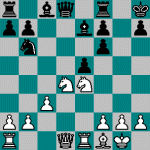
17. 8 August: Old White Rooks.
Looking for the source of that nice rook puzzle in #8, I leafed through the 1910 and 1911 editions of the famous 'White Christmas Series'; 'The White Rooks' and 'More White Rooks'. I didn't find it, but I saw again many of those old Rook problems that are just as witty today as they were 90 years ago.
Here are three.
In case the captions are not too readable; from left to right, they are:
Mate in 4; H. Cordes and A. Keller, Muenchener Neueste Nachrichten Ty., 1891
Mate in 4; S. Loyd, Chess Monthly, April 1859
Mate in 3; O. Dehler, Original (More White Rooks, 1911)Solutions at the bottom.
16. 1 August: Las Vegas odds for Kasparov.
Even if 3 of the world's best 5 players do not play, the tournament in Las Vegas will no doubt be a great and exciting one. But is it a good way to determine a world champion? Let us suppose Kasparov played—what would be his chance of winning? He would be seeded into the second round, and from there on, we will have to let things be decided by a numerical simulation program that I wrote a few years ago.
The ratings of Kasparov's opponents in the third column below are of course speculations—reasonable ones, based on the August 1999 "Professional" rating list on Kasparov's site, where he is #1 with 2838 and Shirov, ironically, is #2 with 2755. Note that in round 6, while Kasparov's estimated % goes down, his chance of winning the match goes up, because a longer mini-match is then played.
Round games rating opponent (est.) predicted % % chance of winning 2 2 2615 80 95 3 2 2648 75 90 4 2 2697 69 84 5 2 2720 66 79 6 4 2731 65 84 7 6 2755 61 80
Kasparov's chance of winning the tournament, then, would be a multiplication of the last column's percentages; some 38 %. This does not seem much for a player who is by far the strongest, with a lead of 83 rating points over the number two—but that is inherent to the knockout-system.
In many sports, e.g. soccer and cycling, a chance of 38 % for the best to become world champion is historically accepted. But in chess? Kasparov has at least 80 % chance of winning any normal tournament. And compare what my simulation says about his chance to remain World Champion if he played a 2755-player a traditional match with a fixed number of games. In the last column, percentages for won and drawn matches have been added. I ran 100,000 matches for each number of games.
No. of games K. wins tie K. loses K. retains title 24 93.1 % 3.3 % 3.6 % 96.4 % 20 90.6 % 4.5 % 4.9 % 95.1 % 16 87.5 % 6.0 % 6.5 % 93.5 % 12 82.8 % 8.8 % 8.4 % 91.6 % 8 75.4 % 13.6 % 11.0 % 89.0 % 4 61.9 % 23.5 % 14.6 % 85.4 % 2 48.5 % 36.0 % 15.5 % 84.5 %
15. 30 July: Re so.
In his commentary on 'Kasparov vs. The World', Danny King writes: 'The World Champion is attacking the Bishop on g7 with the Queen, so it must move, or be protected.'
Generally speaking, I can think of at least 13 other things to do when a piece is attacked.
- interpose a piece
- pin the attacking piece
- give check
- capture the attacking piece
- capture another piece
- attack an opponent's piece
- promote a pawn
- threaten mate
- threaten to promote a pawn
- threaten something else
- set up something that can be played if the piece is captured
- ignore the threat
- mate the king
Granted, not all of them are possible right now.
14. 28 July: Strictly speaking.
On my records page, under the heading 'Greatest number of castlings', I give, without commentary, the famous game Heidenfeld - Kerins in which White castles king's side, then Black castles queen's side, and finally White castles queen's side too.
You'd be surprised at the number of mails I got saying that this is illegal.
I can best answer these helpful readers with an anecdote. In one of his books, Euwe tells what happened when in 1919, the chess editor of a local paper published a game Capablanca - Olland from the Hastings tournament. It was a Queen's Gambit, and Capablanca won quickly with a nice exchange sacrifice Rc1xc6. The problem was that the editor had White's second move as e2-e4 (instead of c2-c4). But apart from 4.c4xd5 which, said the editor, was a mistake for 4.e4xd5, everything tallied. Of course with that pawn still on c2, 10.Ra1-c1 was a truly mysterious rook move, but the real problem was that sac; 18.Rc1xc6. How to deal with this? The editor was not a man easily daunted. He wrote: 'Strictly speaking this move is illegal, but apart from this minor blemish: a beautiful game!'(Euwe was not far off. Capablanca - Olland, Hastings 1919: 1.d4 d5 2.c4 e6 3.Nf3 c5 4.cxd5 exd5 5.Nc3 Nf6 6.g3 Be6 7.Bg2 Nc6 8.O-O Be7 9.dxc5 Bxc5 10.Bg5 Be7 11.Nd4 O-O 12.Rc1 h6 13.Bf4 Qd7 14.Nxe6 fxe6 15.Bh3 g5 16.Bd2 d4 17.Na4 Ne4 18.Be1 Qd5 19.Bg2 Qe5 20.Qd3 Nd6 21.Qg6+ Qg7 22.Qxe6+ Kh8 23.Bxc6 bxc6 24.Rxc6 Nf5 25.g4 Rf6 26.Qe4 Rxc6 27.Qxc6 Rd8 28.gxf5 Bd6 29.Qe4 Bb8 30.Ba5 and Black resigned)
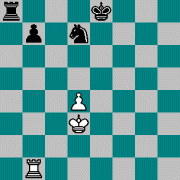
Speaking of castling: thanks to reader Michal Rudolf for sending me this position from a blitz game NN - Macieja, Poland, year unknown. White played 1.Rxb7 and offered a draw. Black played 1...Nc5+ 2.dxc5 O-O-O+ and White resigned. A funny variation to a wellknown trick. The game having been blitz, there is no hope of learning the move number, but it must have been a very late castling.
13. 22 July: New Timman study.
Jan Timman gave me permission to show his latest composition - a very rich and beautiful endgame study.
The position is elegant and gamelike, and as suggested by pawns c4 and c5, and the Nb7, it is inspired by the famous twin combination of Tylkowski - Wojciechowski and Ortueta - Sanz. (See The case of the Polish Rxb2 elsewhere on my site; there is also an earlier Timman-study with this theme in that article.)
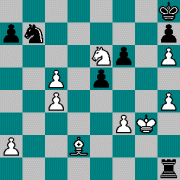
White to play and win Jan Timman Original, 1999 1.Bb4 Before he can play c6, White must prevent Nd6. Black's main defence is now 1...Rb1, but he has several other possibilities:
a) 1...a5 2.c6 axb4 3.cxb7 Rg1+ 4.Kf2 Rg8 5.c5 and White wins
b) 1...Rg1+ 2.Kf2
b1) 2...Rg8 3.c6 Nd8 4.Be7 Nxe6 5.Bxf6+ and White wins
b2) 2...Rc1 3.c6 Rxc4 4.c7 Rc6 (otherwise Bc5) 5.f4! (5.Ke3? f5 6.f4 a5 7.Ba3 e4 and White cannot win) 5...e4 6.f5 and now the white king, other than the black one (Kf7 Nd8+) can approach.
b3) 2...Rb1 3.a3 and White wins more easily than after 1...Rb1, because the black rook has spoiled its access to the 8th rank.
b4) 2...Rd1 3.c6 Nd6 4.Ke2 and wins.
c) 1...Rc1 2.c6 Rxc4 3.c7 Rc6 (otherwise Bc5) 4.Kg4 and White wins more easily than in variation b2, because Black cannot prevent the king marching to d5, e.g. 4...Kg8 5.Kf5 a5 6.Ba3 a4 7.Bb4 and wins.
d) 1...Rd1 (threatening Nd8) 2.c6 Nd6 3.Bxd6 Rxd6 4.c7 Rc6 5.Kg4 Rxc4+ 6.Kf5 and wins.
e) 1...Rb1 The main variation.
Position after 2.a3
2.a3 (2.c6? Rxb4 3.c5 Nxc5 4.c7 (4.Nxc5 Rc4) Ne4+ 5.fxe4 Rc4) (see diagram to the left) 2...a5 (Other defences are easier to deal with, e.g. 2...Rc1 3.c6 Rxc4 4.cxb7, or 2...Rd1 3.c6 Nd6 4.Bxd6 etc. as in d), or again 2...Rg1+ 3.Kf2 and 4.c6 and White wins.) 3.c6 axb4 (3...Rxb4 4.axb4 Nd6 5.c5 Nc8 6.b5 and wins) (see diagram to the right) 4.c5! The Wojciechowski/Sanz move; square d6 is again taken from Black. Black now has three possibilities.
After 3...axb4
e1) 4...Nxc5 5.c7 (5.Nxc5? bxa3 6.c7 Rg1+) Rg1+ (Ne4+ 6.fxe4 Rc1 7.axb4 etc.) 6.Kf2 Rg8 7.Nd8 and wins
e2) 4...Rg1+ 5.Kh3! (h4 must be guarded
10 moves later) Rg8 6.cxb7 bxa3 7.c6 a2 (see diagram to the left.) White now seems lost, but: 8.Nd8! Beautiful magnet move. 8...Rxd8 9.c7 Rg8 and a queen's ending will be reached which is explained below.
Position after 7...a2
e3) 4...bxa3 5.c7 Rg1+ 6.Kh3! (guarding h4 and preventing a nasty check on move 8) 6...Rg8 (Or 6...a2 and now 7.c8Q+ Rg8 8.Nd8! wins, but 7.Ng5 leads to a quicker mate)7.Nd8 Rxd8 8.c6 (had White played 6.Kh2, then Black would now win with Rd2+ and Nd6) Rg8 9.cxb7 a2 (see diagram to the right) 10.b8Q! It is very surprising that this wins, while 10.c8Q does not. 10...a1Q 11.Qxg8+ Kxg8 12.c8Q+ Kf7 13.Qd7+ Kg6 (otherwise pawn h7 is lost with check, and White wins the queen's endgame easily) 14.Qg7+ Kh5 15.Qf7+ and finally we discover why pawn h4 is on the board, and why it had to be guarded 10 moves earlier; it is now mate after 15...Kxh6 16.Qxf6+ Kh5 17.Qg5 mate
Position after 9...a2
There are many things that I like about this study. The choice of b8Q over c8Q, the threefold occurrence of Nd8, each time with a slightly different point, the caterpillar-like march of pawns c4 and c5 to c6/c7, and especially the fact that the last diagram occurs in both e2) and e3)—but with switched pawns b7 and c7!
12. 15 July: Ultimate ultimate.
This really hurts. If not for two doves, I could have enjoyed life for an extra day without knowing this. A month ago, two little city doves crawled out of their eggs on the balcony of my 19th floor apartment. (I must write this, but I have to chase away as many readers as I can before I get to the point.) I watched them grow up, until two days ago, the grey and more hesitant one, like the black one had done a few days before, made its first hop onto the balustrade. Then I did something stupid (placed a big drying rack on the balcony) which made the doves panick and fly away, out into the wide open air, for their first - and as I feared, premature - real flight. The black one returned after a few hours, but the grey one didn't. I was sure it had fallen to death, or had been eaten, but this morning, to my great joy, it was back. I had to write this to B. immediately, and when I got back from mailing the postcard, I picked up the weeklies. In the elevator, I automatically opened one of them, Vrij Nederland, to the chess column and saw a diagram that seemed familiar.
And then I saw my name.
This is (one move later than Dirk Jan ten Geuzendam has it in his column) Langeweg - Krabbé, ch-NL, Zierikzee 1967. It is Black's move, and I resigned, seeing nothing against Qxf7. Not long afterwards, Kurt Richter showed in the Deutsche Schachzeitung that I could have drawn with 32...Rc2 33.Rf1 Rc1 etc. That was bad enough as it was but now, Ten Geuzendam quotes a book Der letzte Fehler by Klaus Trautmann, who shows that I was even winning when I resigned: 32...Rc2 33.Rf1 and now instead of Rc2, Qd2! Trautmann gives: 34.Rg2 Qxg2+ 35.Qxg2 Rxg2+ 36.Kxg2 Bxa4 and wins, or 34.Rh3 Bxa4 35.Kh1 Be8 36.Rg1 Re7 37.Qf6 Qg2+ 38.Rxg2 Rc1+ 39.Rg1 Rxg1+ 40.Kxg1 gxf6 'and Black is winning'. I'm not entirely convinced of those wins, especially not in this last variation, and coming from another sucker, I would probably not have included the case in my story on this site 'The Ultimate Blunder—Resigning in winning positions'.
Black being myself however, I have to.
That must be the ultimate ultimate blunder—collecting them, having made one yourself and not knowing that for 32 years.
11. 12 July: Double swindle.
Via via I received
a request from James Tan, Kuala Lumpur, for the whole game to the position on the left. I don't have it (it probably was a simul game of which only Marshall's ingenious escape was recorded) but I do have something to say about it. Marshall played: 1.Rh6 Rxh6 2.h8Q+ Rxh8 3.b5 with an inevitable stalemate; after 3...Rd7 4.cxd7 c5(6)? 5.bxc6 Kb8 6.Kxb6 White even wins. Other tries do not work, e.g.: 1.Rxf7 Re8 2.Rf8 (2.h8Q Rhxh8 3.Rf8 Kb8 4.b5 Kc8) Rxf8 3.h8Q R8xh8 4.b5 Rxb5 or 1.h8Q+ Rxh8 2.Rxf7 (2.Rh6 Rxh6 3.b5 Rxc6) Ree8 3.Rf8 and again Kb8 4.b5 Kc8
White to play
Marshall - MacClure New York 1923
But 1.Rg6, as one solver showed in a solving contest I held when the dinosaurs were still alive, is an extra solution; 1...fxg6 2.h8Q+ Rxh8 3.b5 or 1...Re8 2.Rg8 Rb8 3.b5 etc., both ending in stalemate.
10. 6 July: Fischer as a chessplayer.
Herman van Riemsdijk, the Dutch-Brazilian master (and webmaster of HyperChess) told me one of those little stories that serve to refresh your awe for the greats. Late in 1971, he'd been in Buenos Aires, and when he went to the chess club there, he met Quinteros and Fischer who were coming down the stairs. Fischer had just won his candidates match against Petrosjan, and was starting a simul tour. Quinteros introduced them, and when Fischer heard the name 'Van Riemsdijk', he immediately said: "In your third matchgame against Medina, he could have refuted your combination if he doesn't take on h5, but plays Rdf1." And rattled off a few relevant variations.
Van Riemsdijk assured me that at that moment, those matchgames had only been in the bulletins of the Hoogovens Tournament, where that match, half a year earlier, had been a little side-show. Neither he nor Medina were players whose doings Fischer had to keep track of, but he knew the games.
Medina - Van Riemsdijk, Wijk aan Zee 1971 m3
1.e4 d6 2.Nc3 e5 3.g3 f5 4.d3 Nf6 5.Bg2 Nc6 6.f4 exf4 7.Bxf4 fxe4 8.Nxe4 Nxe4 9.Bxe4 Qe7 10.Ne2 Bg4 11.h3 Bh5 12.Qd2 d5 13.Bxd5 Nd4 14.g4 O-O-O 15.Bg5 Qe5 16.Bxd8 Qxd5 17.O-O-O Qxa2 18.Nc3 Qa1+ 19.Nb1 Bd6 20.Bg5 Nb5 (See diagram. After 21.Rdf1, White is better, and after the intended 21...Na3 he even wins: 22.bxa3 Bxa3+ 23.Kd1 Re8 24.Be3 Qxb1+ 24.Ke2) 21.gxh5 Na3 22.Qc3 Nxb1 23.Qb3 Nc3+ 24.Kd2 Nxd1 25.Qb5 Qxb2 26.Qf5+ Kb8 27.Kxd1 Qb1+ 28.Bc1 Rf8 29.Re1 b6 30.Qd7 Kb7 31.Qa4 Bb4 32.Re4 Rf1+ 33.Ke2 Qxc1 0-1Over the next few days, Van Riemsdijk met Quinteros and Fischer a few more times. He remembers Fischer saying that Spassky would be no problem; his real opponent in the future would be Karpov. But Karpov, then 20, still had to learn, and Fischer showed a few positions where Karpov had made mistakes. Quinteros and Van Riemsdijk couldn't follow it; Fischer was too fast.
9. 1 July: Starflight.
Nabokov yet again—what can I do against chance, and this being his centennial year.
A friend who visited the 'Nabokov under glass' exhibition in the New York Public Library (5th Ave. & 42nd St.; opened till August 21) brought me its little program book. It has the facsimile of a page from a 1919 notebook, with a diagram drawn by the 20- or 19-year old Vladimir of a chess problem—one that has never been published before.
It is not a great problem (coming from an anonymous it would hardly be published today), but for a beginner, in 1919, it is really good. The solution of this two-mover is not difficult (but that is not the point of a good problem) and in a way, even obvious.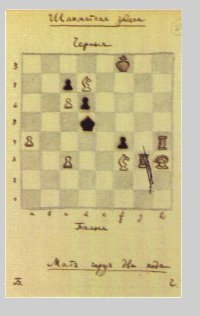
The black king has three white flight squares, without mates being provided for these flights, which suggests giving him a fourth. 1.Bg2 therefore presents itself, especially when you notice that it prepares mates for all the flights, and for the king remaining on its original square.
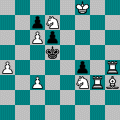
Mate in 2 V. Nabokov, 1919
1.Bg2
Kxc6 2.Nfe5 mate
Ke6 2.Nd4 mate
Kc4 2.Nd2 mate
Ke4 2.Nd4 mate
fxg3 2.Ng5 mate
The five variations together are the theme; 'starflight'. (With orthogonal squares it is called plus- or cross-flight.) Starflight is one of the oldest themes in problem history; the first one was constructed in 1852. It has later been used for very ingenious and complicated problems, where for instance White has mates ready for the entire star, but no key with which he can keep these mates. There is a key however which still allows the star, which is now met by new mating moves - which are sometimes related to the original ones in some amazing way.
Nabokov's problem, in its simple prettiness and purity, suggests he has just invented starflight himself.
8. 28 June: Twistin' the night away.
Received "Chess Braintwisters" by Burt Hochberg, a collection of 111 chess-problems and -puzzles, ranging from the off-beat to the very off-beat. Added squares, dummy pawns, mate in 0, billiard chess, retractors, phantom castling. In this medieval puzzle (it dates back to the 15th century) that I had never seen before, the caption reads: Place four White rooks on the board one at a time, giving check with each of them and checkmate with the fourth. Black moves normally.
Hochberg writes he showed this to a couple of top grandmasters once, and that only Keres, but after something like 10 minutes, saw how to do it. In case you want to try it yourself: the solution is at the bottom.
7. 23 June: An early claustrophobic knight.
In Edward Winter's column Chess Lore at The Chess Café, I was struck by the claustrophobic position on the left, from a game Rose – Johnston, Chicago 1898. It's Black's move, and you'd say he should win, but how can he ever break into the fortress of White's king? He managed that with 1…Qc1+! The bishop must first be forced over the critical square f2. After 1...Qe1+ 2.Kg2! (2.Bg1? Qf2!) Qg3+ 3.Kh1 Qf2, White has 4.Be7! and I don't see how Black can win (4...Qe3 5.Bxg5 Kf2 6.Bh4+) 2.Bg1 Qe1 3.Kg2 Qg3+ 4.Kh1 Qf2! and, the bishop now being boxed in too, White had nothing better than 5.Bxf2 Kxf2 6.Nf1 Kxf1, and Black won.
This strange and unknown endgame anticipated, by 16 years, an endgameso famous it even has its own stamp.
In this 'Capablanca - Lasker', where the positions of king and knight are reversed, but the knight is no less claustrophobic, there followed 1.Nxc7 Nxc7 2.Ra8+!! Nxa8 3.Kc8 and Black resigned.
The reason for the parenthesis is that a game with that ending can be found nowhere, and that the position of the stamp, no matter how often it has been reprinted as 'Capablanca - Lasker', has never really occurred. What did happen is, according to Dale Brandreth in 'The Unknown Capablanca', that in 1914 Capablanca and Lasker met in Berlin, where they played a short blitz match (I wonder what sort of blitz, I can't really picture them demolishing clocks), won by Capablanca with 6½-3½. The stamp-endgame arose in the post-mortem of one of those games, and must be seen as a joint composition by the two world champions. Lasker then published it in his column in Der Vossische Zeitung, apparently worded in a way that left room for him to become the loser.
Any pre-1898 examples of the claustrophobic knight?Thanks to Colin Rose for letting me use the JPG that I found on his marvelous site Chess on stamps.
6. 20 June: An unknown Saavedra.
In the Dutch endgame magazine EBUR, June 1999, I saw a beautiful endgame study which combines two of my favorite composers, Gurgenidze and Kalandadze, and three of my favourite themes: the Saavedra, the Prokeš manoeuvre, and the 'unguarded guards' theme. It was uncovered by the undefatigable Harold van der Heijden who collects, among almost everything else in the field of endgame studies, Saavedra-variations.
The starting position, admittedly, is ugly. And the first move easy. 1.Ba7 is forced. Now, as Rf8 or Rh8 fail to 2.Bxd3, Black's only chance is to capture pawn d7 with check—a Prokeš-manoeuvre of sorts. 1...d4 (Clearing the d-line.) 2.Bxd4 g1Q+ (Clearing the d-line again.) 3.Bxg1 d2+ 4.Kd1! (and not 4.Kc2 d1Q+ 5.Kxd1 Rxd7+ followed by Rxc7 and Black draws) 4...c2+ 5.Kxc2! (and not 5.Kxd2 Rxd7+ 6.Bd4+ Rxd4+ 7.Kxc2 Rc4+!) 5...d1D+! (5...Rxd7 6.Bd4+! Rxd4 7.Kd1! and wins) 6.Kxd1 Rxd7+ 7.Bd4+ First unguarded guard. 7...Rxd4+ Now on Ke1 or Ke2, Re4+ and Re8 is a draw, and on Kc1 or Kc2, Rc4+ is a draw. But: 8.Bd3! Second unguarded guard. 8...Rxd3+ 9.Kc2 and finally we have the original Saavedra: 9...Rd4 10.c8R Ra4 11.Kb3 and wins.
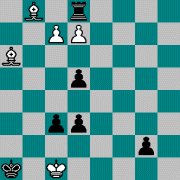
White to play and win
D. Gurgenidze &
V. Kalandadze
Magyar Sakkélet 1975
As Harold van der Heijden rightfully remarks: strange that this masterpiece remained so obscure for a quarter century.
5. 14 June: Which book?Nabokov again.
In a Dutch paper, I found this picture of Vladimir Nabokov and his wife Véra playing chess, in 1968, in Montreux.Could anyone tell me which book could be on the table here? It seems to be a large book, with 9 diagrams per page, in 3 rows of 3.
Some books it looks like, but is not:
- A volume in Wildhagen's series Weltgeschichte des Schachs
- Josef Breuer's Beispiele zur Ideengeschichte des Schachproblems
- Lommer & Sutherland's 1234 Modern End-Game Studies
- Lommer's 1357 End-Game Studies
- An early Informator
- Henri Rinck's 1414 Fins de partie
- Alexandre's The Beauties of Chess
4. 10 June: Boys under 16 will be boys.
In 'Schaakmagazine' (the Dutch official national magazine) for June, Dutch Boys-under-16 champion 1999 Jan Werle names his 'funniest game' from that championship. I'm not sure 'funny' is the right word.
1. 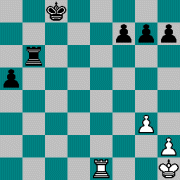
White to playAfter 33 not-too-inspiring moves in Werle (2223) - A. (2140) (I will not give his full name, as he is only 15, a good player, and does not deserve to be hounded by this for the rest of his life), the position of diagram 1 had been reached: a rook endgame where Black is two clean pawns up. Play continued: 34. Re8+ Kd7 35. Ra8 Rb5 36. Ra6 h5 37. h4 Ke7 38. Kg2 f6 39. Ra7+ Kf8 40. Kf3 Kg8 41. Kg2 Kh7 42. Kf3 Kh6 43. Ra6 Rb3+ 44. Kg2 Ra3 45. Kh2 Ra2+ 46. Kg1 Kg6 47. Ra7 a4 48. Kh1 a3 49. Kg1 Ra1+ 50. Kg2 (diagram 2)
2. 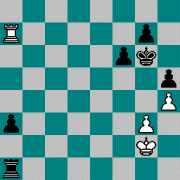
Black to play50...a2 Not the easiest win; a2 is needed as a hole for the Black king. 51. Ra5 Kf7 52. Ra6 Ke7 53. Kh2 Kd7 54. Kg2 Kc7 55. Kh2 Kb7 56. Ra3 Kb6 57. Kg2 Kc5 58. Ra7 g6 59. Kh2 f5 60. Ra8 Kc4 61. Ra7 Kb3 62. Rb7+ Kc3 63. Rc7+ Kd3 64. Ra7 White could also go on checking—but maybe this was a trap. We're in diagram 3 now. 3. 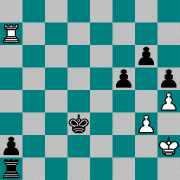
Black to playAnd indeed, Black saw a win, finally. 64...Re1? Neither does 64...Rc1 win; 65.Rxa2 (or 65.Ra3+ Rc3 first) Rc2+ 66.Rxc2 Kxc2 67.Kg2 and White draws. This is also a draw, but a more stupid one. 65. Ra3+ And the a2 pawn is lost. 65...Ke2 66. Rxa2+ Kf3 67. Ra6 And immediately, a second pawn goes. 67...Re2+ 68. Kh3 Re4 69. Rb6 Kf2 70. Rxg6 Rg4 (diagram 4) 4. 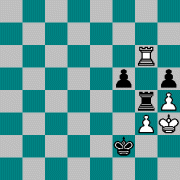
White to playHe may have believed he was winning after all. However, he was in for an ugly surprise. 71. Rg5 A third pawn goes. 71...f4 72. gxf4 Rxf4 73. Rxh5 Now Black must fight for a draw, but that should not be too difficult. 73...Kf3 74. Rg5 Rf8 75. h5 Kf4 76. Kh4 Rb8 (I let this move pass without comment at first, but reader Rolf Tueschen noted that it loses. White must stop the pawn from advancing; Rh8 or Rf6 was correct.) 77. Rg7 (More question marks; 77.h5 wins. Now everything is back in order.) Kf5 78. Rf7+ Ke6 79. Rf3 Ke7 80. h6 Rf8 81. Rg3 Kf7 82. Rf3+ (diagram 5) 5. 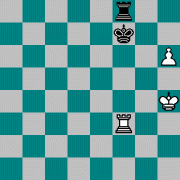
Black to playAnd, almost as if obeying some poetic necessity, Black played 82...Kg8?? The horror, the horror. After Ke7 or Ke8, it was still a draw. 83. h7+ Black resigned.
21 June: A reader sent me a remarkable footnote to this. Understandably, he was 'too modest' to need to see his full name with this game.In Ruchieva (2235) - R. (2280), Warsaw 1992, the position on the left arose after 45 moves. In a double rook ending, in almost the same configuration, Black is again two clean pawns up. The game continued: 45...Ke5 46. Rb7 h5 47. Rd7 d4 48. Rb3 Kf6 49. Rd3 Re4 50. Rd6+ Kf7 51. Rd8 Ke7 52. Rd5 Ke6 53. Rd8 Ke5 54. Rb3 Ra5 55. Rg8 Rg4 56. Rd8 Rc5 57. Rd3 Rc6 58. Rd7 Rd6 59. Ra7 Kd5 60. Ra4 Rb6 61. Rda3 Kc5 62. Ra8 Rb5 63. Rc8+ Kb4 (see diagram to the right) 64. Ra1 and Black resigned.
3. 17 May: Oll, Luzhin, Nabokov, Von Bardeleben.
Grandmaster Lembit Oll committed suicide by jumping out of the window of his 4th floor apartment in Tallinn, Estonia. Somebody told me he sometimes introduced himself as: 'Lembit Oll, 2650.'
Of course his manner of death reminds one of that of Luzhin, the sad hero of Nabokov's "Luzhin's Defense". This in turn was inspired by the suicide of the Berlin master Curt von Bardeleben in 1924. There cannot be much doubt that Nabokov in fact was inspired by this, as he wrote, in his 1970 foreword to the English edition of his novel 'Glory' (1932):My wife and I, who were then still childless, rented a parlor and bedroom on Luitpoldstrasse, Berlin West, in the vast and gloomy apartment of the one-legged General von Bardeleben, an old gentleman solely occupied in working out his family tree; his large brow had a somewhat Nabokovian cast, and, indeed, he was related to the well-known chess player Bardeleben whose manner of death resembled that of my Luzhin.
2. 23 April: The Scrap.
Hanon Russell was in Amsterdam, among other things to donate to the Max Euwe Center a scrap of paper on which Bobby Fischer had, in 1962 at the Olympiad in Varna, told his teamcaptain Elliott Hearst that he resigned his adjourned game against Donner, and wanted to be left sleeping.
Russell held a little speech about the circumstances of that game, that Olympiad, and the much more memorable game Fischer played a few days later against Botvinnik. When Russell was through, and the document had been handed, and there had been a little applause, an official of the Center, who had been taking notes for an article in its publication, asked: 'Now, Fischer - how do you spell that?'
1. 20 April: Kid promotion.
A thread on rec.games.chess.misc, "My sons (3 and 5) won't even touch chess, stupid kids", made me think of my own son's first steps in chess, at five. In one game, I let him queen a pawn, and as he still had his original queen, I put a captured rook in its place upside down. A few moves later, when I captured this new queen, and put the rook beside the board, he demanded that it be placed upside down there, too.
© Tim Krabbé, 1999
Solution to #8:
There are six solutions: Ra5, Rd8, Rd2, Rd1, Rg5 and Rh5. Once you've hit upon the idea that you can build a vertical box for the black king by giving it a horizontal check (or the other way round), you have found the solution. In fact, any check from a distance of at least 3 squares works; e.g. 1.Ra5+ If Black now goes up, then obviously putting the rooks on top of each other will do. But if he goes down, then White checks him on the second rank, and Black is boxed in between that rank and the fifth. E.g. 1...Kc4 2.Rc2+ Kb3 3.Rc3+ and 4.Ra4 mate.PS 5 january 2000:
Reader Eric Roosendaal shows a funny extra solution: 1.Rb5+ and after 1...K~6, 2.Rb6+; 1...Ke4 2.Re2+; or 1... Kd4 2. Rd2+ it works as before, but 1...Kc4 seems to be a refutation. However, 2.Rc2+! and now after Kd~ putting two rooks on the c-file works, but the proof of the pudding is: 2...Kxb5 3.Rb2+ and 4.Ra2 mate.
Of course 1.Rd7 works in the same way, making 8 solutions in all.
Solutions to the rook problems of #17:
Loyd: 1.Rh2
Cordes & Keller: 1.Rdd4
1...exd4 2.Rxd4 exf5 3.Rf4 b4 4.Rxf5 mate (2...e5 3.Re4 and 4.Rxe5 mate)
1...exf4 2.Rxf4 exf5 3.Ka7 b4 4.Rxf5 mate (2...e5 3.Re4)
1...exf5 2.Rde4 and here the old descriptive notation is efficient: 2...PxR is met by 3.RxP, and mate next move. I like that move 2.Rde4 enough to give it an extra diagram.
1...Kxh4 2.Kf4 h6 3.R- h2 4.Rxh2 mate
1...Kxh2 2.Kf2 h6 3.Rxh5 Kh1 4.Rxh3 mate
1...h6 2.R2xh3+ Kg2 3.Ke2 Kg1 4.Rg3 mateDehler: 1.Rh5 h6 2.h4 Kh2 3.Rh3 mate
Next entries | Current Open Chess Diary
Top | Main chess page | Main page | Contact me